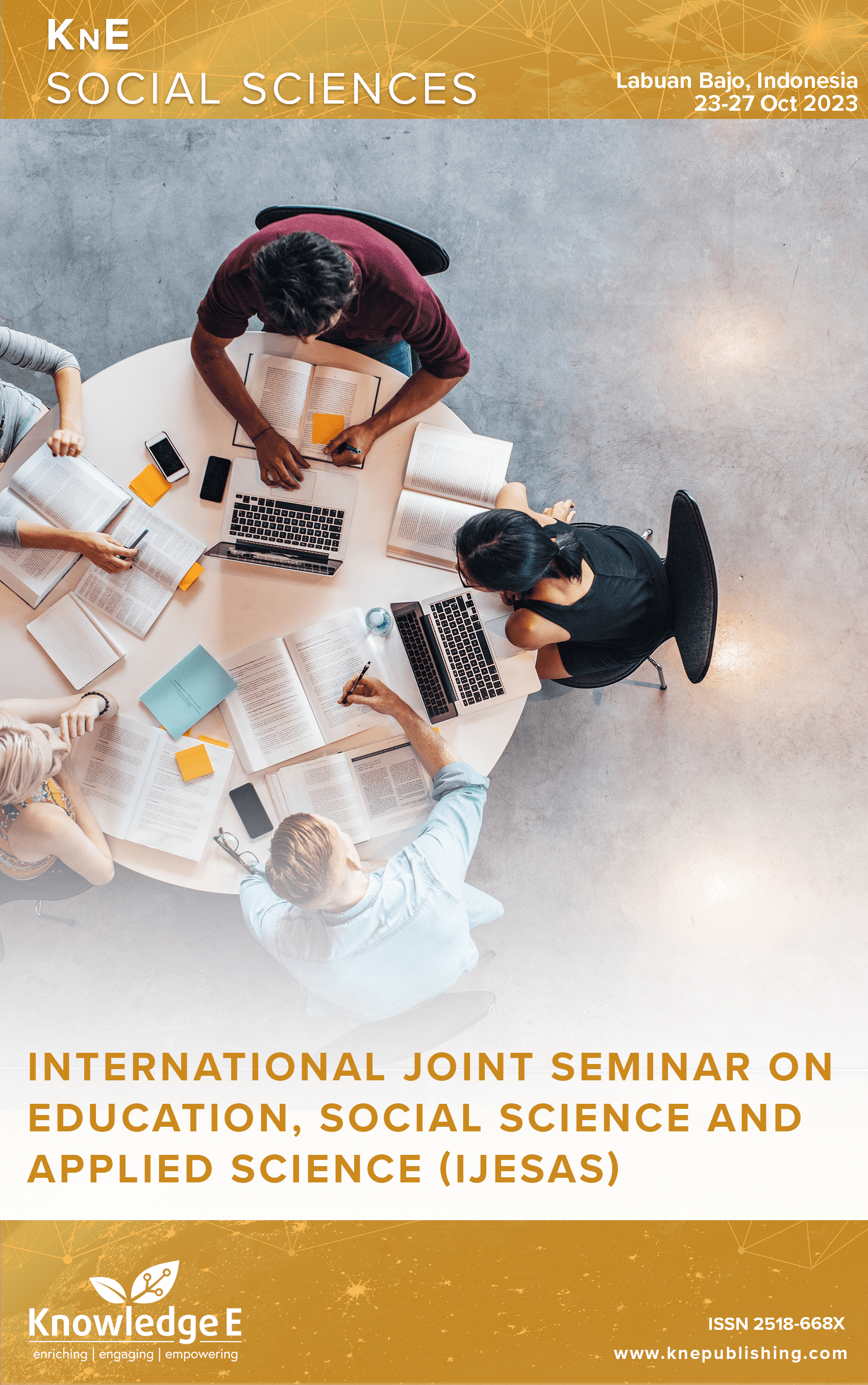Beyond Stereotypes: Personal Perceptions Study of Tionghoa Ethnicity on Relations with Indonesian Society
DOI:
https://doi.org/10.18502/kss.v9i19.16468Abstract
Indonesia is a country with diverse tribes, religions, ethnicities, and traditions. Although Indonesia makes a unique contribution to the life of the archipelago and its citizens, it does not rule out the risk of disputes and conflict. One of them is the existence of ethnic differences, which give rise to stereotypes of certain ethnicities, such as Tionghoa. Not all stereotypes are justified and real. Indonesian history records the existence of social conflicts born from inter-ethnic stereotypes, such as during the 1998 riots. Therefore, this research aims to explore individual lived experiences and subjective viewpoints and provide a platform for authentic voices that are often unheard in discussions of ethnicity and identity. So, this article provides insight into how ethnic Tionghoa people strengthen their perceptions of existing stereotypes. This research uses a qualitative approach with a case study method. The research data was obtained through interviews with 30 ethnic Tionghoa people accompanied by participant observation. In contrast, data analysis took a thematic approach to identify patterns and themes that emerged from the results of interviews and observations. The research findings show that an understanding of the diversity of individuals and society that has not been fully accepted reflects challenges, including political history that influences negative perceptions. Unfortunately, the complexity of social relations means that some informants feel that the Tionghoa ethnic community tends to be closed, creating the impression of a lack of unity in Indonesian society. This research is important to explore how the reality of the lives of ethnic Tionghoa people does not fully conform to the prevailing stereotype.
Keywords: stereotypes, Tionghoa, public relations
References
Liliweri A. Pengantar studi kebudayaan. Nusamedia; 2019.
Nordholt HS, Purwanto B, Saptari R. Perspektif baru penulisan sejarah Indonesia. Yayasan Pustaka Obor Indonesia; 2008.
J.I. Tjen, “Interaksi Kelompok Etnis Tionghoa dengan Etnis Non-Tionghoa Dalam Perguruan Tinggi Negeri: Studi Tentang Pemilihan Institusi oleh Mahasiswa Etnis Tionghoa,” (2023).
Syuhudi I. Pergulatan Kepentingan Politik Dalam Relasi Inter Denominasi Kristen Di Manado. Al-Qalam. 2018;24(2):235–45. DOI: https://doi.org/10.31969/alq.v24i2.536
Y. Guo-qiang, “… and the Reflection of Chinese People in the Early Years of the Republic of China: The Notional Rising of the Constitution, the Congress, Political Parties as well as ….,” Journal of East China Normal University …. p. 2018.
Zhang C, Zhang J, Guo Q. “Can Political Connections Of Independent Directors Improve Firm Perfomance? Evidence Of Chinese Listed Manufacturing Companies Over 2008-2013.,” Malaysian E Commerce Journal …. p. 2018. DOI: https://doi.org/10.26480/mecj.01.2018.05.12
Ang I. On not speaking Chinese: Living between Asia and the West. Routledge; 2005. https://doi.org/10.4324/9780203996492. DOI: https://doi.org/10.4324/9780203996492
Li X. Understanding China’s economic success:‘Embeddedness’ with Chinese characteristics. Asian Culture and History. 2016;8(2):18–31. DOI: https://doi.org/10.5539/ach.v8n2p18
Yen-Ling T. Spaces of exclusion, walls of intimacy: Rethinking ‘Chinese exclusivity’ in Indonesia. Indonesia. 2011;(92):125–55. DOI: https://doi.org/10.5728/indonesia.92.0125
M. Khoiri and I. Irwan, “Nasionalisme Masyarakat di Perbatasan Indonesia-Singapura: Studi Kasus Masyarakat Tionghoa-Batam.,” Journal of Moral and Civic Education. p. 2020. https://doi.org/10.24036/8851412412020232. DOI: https://doi.org/10.24036/8851412412020232
N. Ro’ufah, “Stereotip dan Prasangka dalam Komunikasi antar Budaya: Studi Harmoni Sosial antara Etnis Jawa dan Etnis Tionghoa di Yosomulyo Banyuwangi.,” (2018).
Kuntjara E, Hoon CY. Reassessing Chinese Indonesian stereotypes: two decades after Reformasi. South East Asia Res. 2020;28(2):199–216. DOI: https://doi.org/10.1080/0967828X.2020.1729664
Allen P. Literature and the Media Contemporary Literature from the Chinese’Diaspora’in Indonesia. Asian Ethn. 2003;4(3):383–99. DOI: https://doi.org/10.1080/1343900032000117213
Kuntoro IA, Peterson CC, Slaughter V. Culture, parenting, and children’s theory of mind development in Indonesia. J Cross Cult Psychol. 2017;48(9):1389–409. DOI: https://doi.org/10.1177/0022022117725404
Tong CK. Identity and ethnic relations in Southeast Asia: Racializing chineseness. Springer Science & Business Media; 2010. DOI: https://doi.org/10.1007/978-90-481-8909-0
A. Azizi, “Pandangan Masyarakat Banda Aceh Terhadap Stereotip Masyarakat Pidie Dan Padang,” (2022).
Huang G, Fowler CJ, Baskerville RF. Entering the accounting profession: the operationalization of ethnicity-based discrimination. Account Audit Account J. 2016;29(8):1342–66. DOI: https://doi.org/10.1108/AAAJ-07-2015-2153
Shih KY, Chang T, Chen S. Impacts of the model minority myth on Asian American individuals and families: social justice and critical race feminist perspectives. J Fam Theory Rev. 2019;11(3):412–28. DOI: https://doi.org/10.1111/jftr.12342
D.S. Truna and T. Zakaria, Prasangka Agama dan Etnik. Prodi S2 Studi Agama-Agama UIN Sunan Gunung Djati Bandung, 2021.
Novitasari N, Fauziah NM, Mazid S, Nufus AB, Yasnanto Y, Widiyanto E. “PENYULUHAN MENANGKAL RADIKALISME MELALUI PENGUATAN KARAKTER SISWA DI MTS ARROSYIDIN MAGELANG.,” Civitas Ministerium. vol. 4, no. 01, p. 2020.
Y. Audrey, “Representasi Identitas Etnis Cina dalam Film Dimsum Martabak (2018),” (2023).
Nihaya N. Radikalisme Dan Pengaruhnya Terhadap Pemahaman Masyarakat Islam Di Kelurahan Samata Kecamatan Somba Opu Kabupaten Gowa. Sulesana: Jurnal Wawasan Keislaman. 2018;12(1):16–35.
Yu T. Challenging the politics of the ‘model minority’ stereotype: A case for educational equality. Equity Excell Educ. 2006;39(4):325–33. DOI: https://doi.org/10.1080/10665680600932333
Grobet A. Responsible reporting and perceptions of migrants in an era of unprecedented mobility. Reporting at the southern borders. Routledge; 2013. pp. 47–61.
Nurrahmi F, Putra FG. Stereotip dan komunikasi interpersonal antara etnis aceh dan etnis tionghoa. Jurnal Studi Komunikasi. 2019;3(2):199–214. DOI: https://doi.org/10.25139/jsk.v3i2.1473
Abramson MS. Ethnic Identity in Tang China. University of Pennsylvania Press; 2008. https://doi.org/10.9783/9780812201017. DOI: https://doi.org/10.9783/9780812201017
Baolian Qin D. Being ‘good’ or being ‘popular’ gender and ethnic identity negotiations of Chinese immigrant adolescents. J Adolesc Res. 2009;24(1):37–66. DOI: https://doi.org/10.1177/0743558408326912
Achmad Busrotun Nufus SM. Novitasari, Pendidikan Pancasila sebagai paradigma pembangunan. Malang: Madani; 2018.
Dianto I. Hambatan komunikasi antar budaya: menarik diri, prasangka sosial dan etnosentrisme. Hikmah. 2019;13(2):185–204.
Nugroho OH. “Meretas Damai Di Tengah Keberagaman: Mengembangkan Pendidikan Kristiani Untuk Perdamaian Dalam Perspektif Multikulturalisme.,” Gema Teologi. vol. 38, no. 2, p. 2014.

